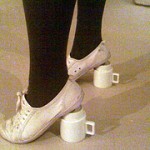Unless you’ve been orbiting in the space shuttle or hiding in an Afghan cave this week, you’re aware that it’s a big week for moms. Media hype and advertising = skyrocketing expectations about the perfect way to honor mom this Mother’s Day. Blah, blah, blah. Just as with any holiday–or for that matter, any regular old run of the mill day–unrealistic expectations are the most powerful, direct route to disappointment. The more we expect, the more hopes can be dashed.
I remember the painful first year that I didn’t have a daughter at home on Mother’s Day. My husband tuned in to my angst and made plans (earning many husband points!) I’d always loved the fancy hotel Mother’s Day brunches, and he surprised me with brunch reservations. Given the holiday crowd, the hotel moved the event to the massive, dim, chandeliered ball room, away from the usual intimate, sunny garden cafe setting. There we sat at a tiny “two top” in the midst of lively parties of dozens of family members, from great grandmothers to infants– most clad in gay spring hats! Just our little 2 person table, awkwardly adrift in this sea of flowering families. Given my expectations for a great time, I was surprised at how bereft I felt.
What’s a mother to do?
1. Ask for what you want. We’d like to think that on this day, out of the whole year, our loved ones will just know what we want. But family members are simply human, and likely not psychic. And don’t be afraid to ask for them all to disappear for the day, if time alone is what you truly crave. Or here’s a fun list of truly invaluable gifts.
2. Stay in the moment, and recognize the love in the intent. Embrace whatever is offered in celebration.
Too often we’re like cats in our expectations: we demand it all. At least silently, in the solitude of our minds, we expect to be pampered, stroked, fed all earthly delights between lengthy, luxurious naps, as the world revolves around us. At least for one measly day a year.
Not that mothers don’t deserve it. Parenting is the hardest job we’ll ever do, and a cat’s life is what moms deserve. However, “deserve” and executed reality don’t always align, and then disappointment can rush in. Unless we meow, or maybe howl, really loudly, for what we want. Refer to #1 above!
However, a better way might be to live in the moment like dogs. To dogs, every day is the best day ever: “I chased a squirrel!!!!” “I smelled a rotten smell!!!!” “I got scratched behind the ears!!!” “I got to go for a walk!!” Most wondrous day ever!!! In the current issue, Psychology Today explains that those who are happier, and luckier, definitely adopt this canine attitude, embracing wonder in every twist and turn of life. Woof, woof!!
On <em>The Sanity Hour this week, guest Cheri Ruskus shared this poem written by her mother Jeannine Landreau. Cheri discovered the poem after her mother’s death last year.
Do not take this moment lightly for it is the most important moment of your life
It is all there is of the present. Live it to the fullest for it will never come again.
All that has gone before it is a memory and all that will come after it is only a hope or dream of future things.
It is more than the beginning of tomorrow and the end of yesterday.
Make it a great moment, it is your life right now and you will never live it again!
Rein in your expectations this Mother’s Day, ask for what you want, and hope for perfect moments, not a 110% perfect day. With canine expectations for every moment, every day, the joy of Mother’s Day might extend throughout the year.
Happy Mother’s Day.
 Go ahead–have a powerful internal scream. Embrace your truly human emotions. Cut yourself some slack about thoughts. Focus instead on actual behavior–big picture, over the long haul. You’ve thought of walking out of a store with your purchases rather than stand in a mile-long line, too. There’s nothing the matter with you, if you override thoughts and behave in the ways you aspire to, the majority of the time.
Go ahead–have a powerful internal scream. Embrace your truly human emotions. Cut yourself some slack about thoughts. Focus instead on actual behavior–big picture, over the long haul. You’ve thought of walking out of a store with your purchases rather than stand in a mile-long line, too. There’s nothing the matter with you, if you override thoughts and behave in the ways you aspire to, the majority of the time.



